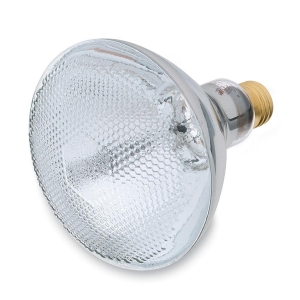
Question: Is there a more energy efficient bulb than a halogen flood lamp I could use to light my kitchen in Washington State?
Answer: Halogen lights, just as regular incandescent lightbulbs, let electricity flow though a filament which in turn heats up so much that it starts glowing. Most of the energy used is therefore turned into heat rather than light.
The other two main technologies to create light in residential applications are fluorescent and LED. Both are somewhat similar in efficiency compared to traditional and halogen bulbs.
Pros and cons of LEDS and fluorescents
LEDs:
+last nearly forever
+very small
+available as direct replacement bulbs for most fixtures
+instant warmup
-expensive
-uneven color rendition
-relatively low light output
Fluorescent and compact fluorescent (CFL)
+last long compared to regular bulbs
+inexpensive compared to LED
+high output
-long warmup time, therefore recommended where lights stay on for 15minutes minimum
-not as compact as LED, and therefore not available as direct replacement in smaller fixtures
Your only option
In your case, a LED will be your only option unless you are willing to switch out the fixtures for dedicated high efficacy fixtures (that are made from the ground up for LED or CFL).
If your small Halogens are currently 25W, a good LED direct replacement bulb will be able to create a similar light output. If they are 50W, you may have to live with a little less light. A wide variety of resellers are selling these nowadays on the internet, just google "Halogen replacement LED" and you will find many offers.
- Make sure you buy a product that is dimmable.
- Each bulb will be around $30.
Know that heat is not necessarily wasted energy
One part in the discussion of energy efficient lighting that is often overlooked is that just because a traditional light bulb turns 80% or more of the energy into heat, that does not necessarily mean that energy is wasted.
- It depends largely on the space the bulb is installed in.
- For a house in a very cold region, that is heated most of the year, the "inefficient" light bulb simply takes a load of the heating system.
If we, for example, take a 25W Halogen bulb that puts out 5W light and 20W heat (for the ease of calculation) and the heat is switched on anyway in the house, the 20W are only wasted to the extent that the heating system would be more efficient at the task of heating than the lightbulb.
Let's look at three common heating systems:
- Electric radiators: just as inefficient as the lightbulb. No energy is wasted.
- Electric heat pump: needs about 8W to create 20W of heat, so we waste 12W with our bulb.
- Gas heat: gas and electric are not always easy to compare heat sources, but a good rule of thumb is that gas is two to three times more efficient for heating purposes than electricity. This would make it about equal to the heat pump calculation above.
If, on the other hand, the space that the lightbulb is in needs to be cooled artifically, things shift dramatically. This would be the case in many office buildings, and in all buildings in warm and hot climates that have a/c.
- Now not only does the bulb waste 20W, we need to expend more energy to get these 20W out of the house again.
- A regular a/c will need about 50W of electricity to do this. If we total it up, the lightbulb now uses 75W in total electricity to produce 5W of light.
Southern vs northern climates
In short, if you have a/c in your house it gets exponentially more important to use energy efficient appliances, especially light bulbs. The more you heat however, and the more inefficient your source of heat, the longer the environmental and financial payback period.
As you live in Washington you probably heat with natural gas, a very efficient heat source. Your carbon footprint will therefore shrink by using LED bulbs, just not quite as much as the manufacturer may claim.
Readers that live in southern states, I hope you can take away from this article that energy efficient lightbulbs make a huge difference in your power consumption due to the added cooling load.
- Please consider upgrading to LED and CFL bulbs wherever possible.
- The same goes for other appliances (for example induction cooktops rather than regular or gas cooktops) in your areas.
This article "Is there a more energy efficient lamp that I could use? I am using dimmable halogen flood lamps in my kitchen's recessed lighting?" originally appeared in the USGBC's Green Home Guide - an excellent source for green home expertise, ideas, and connections.
Florian Speier is the founder of Zeitgeist Design, a firm that strives to fuse the best design, technologies and materials from the U.S. and Europe in all of their projects.

